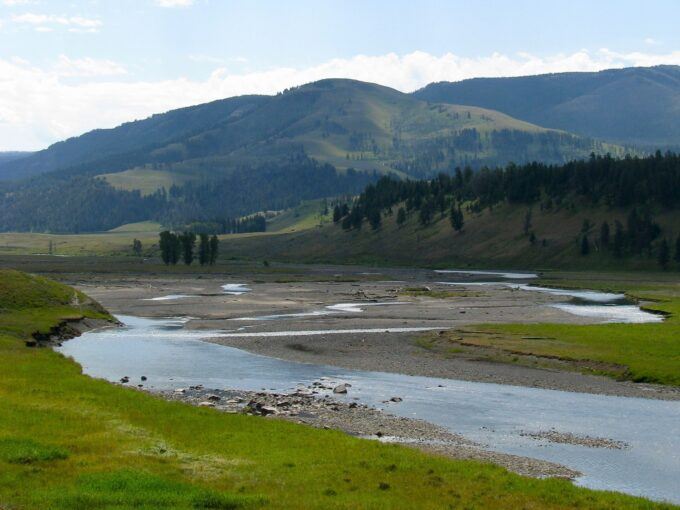
Lamar River Valley, Yellowstone. Photo: Jeffrey St. Clair.
It’s springtime in the Rockies, where one day record high temperatures sweep the state and the next day we have winter storm warnings.
In between the freeze-thaw cycle, the snowpack begins to melt, once again filling the rivers to full and beyond. It’s nature in all its incredible diversity and wonder — and in Montana, Mother Nature still calls the shots but she gets a significant helping hand from citizen environmentalists and conservationists.
Thousands of snow geese just passed through Montana on their northward migration. For conservationists, it’s very rewarding to see the positive result of tirelessly advocating to preserve the habitat on which these massive flocks rely going north, coming south or overwintering far from Montana’s northern flyway.
As the brown hills begin to “green up,” you can almost feel the joy of the elk, deer and antelope finally getting something fresh to eat besides dried brown forage, sagebrush and pine needles. And again, these healthy populations of native wildlife are proof that the efforts to maintain them — including banning game farms by citizen initiative to keep them disease-free — have again proven their worth. Soon enough, new fawns and calves will be frolicking with the herds.
Our incredible rivers and streams are likewise headed for renewal as the mountains release winter’s snowpack. For the freestone streams that support our internationally famous wild trout fisheries, the rush of runoff scours the cobbled riverbed, removing the sediment that would smother trout eggs and the aquatic insects upon which the trout feed.
But runoff scouring the gravel beds isn’t the only thing our rivers require. And in that regard, there’s a bit of good news for the beleaguered Gallatin River. Thanks to the efforts of citizen environmentalists and conservationists, the Montana Department of Environmental Quality has finally submitted a proposal to the Environmental Protection Agency to list a long stretch of the Upper Gallatin as “impaired by algal growth.”
The designation would cover the 40-50 mile stretch from where the Gallatin leaves Yellowstone National Park to the confluence with Spanish Creek below Big Sky. It may not sound like much of a victory to have one of Montana’s famous Blue Ribbon trout streams listed as “impaired.” But that designation actually initiates a process to investigate and reduce the excess nutrients that have turned miles of the river downstream from Big Sky neon green for the last five years.
But runoff scouring the gravel beds isn’t the only thing our rivers require. And in that regard, there’s a bit of good news for the beleaguered Gallatin River. Thanks to the efforts of citizen environmentalists and conservationists, the Montana Department of Environmental Quality has finally submitted a proposal to the Environmental Protection Agency to list a long stretch of the Upper Gallatin as “impaired by algal growth.”
The designation would cover the 40-50 mile stretch from where the Gallatin leaves Yellowstone National Park to the confluence with Spanish Creek below Big Sky. It may not sound like much of a victory to have one of Montana’s famous Blue Ribbon trout streams listed as “impaired.” But that designation actually initiates a process to investigate and reduce the excess nutrients that have turned miles of the river downstream from Big Sky neon green for the last five years.
For those of us who fished these holy waters 50 years ago, it’s no great mystery where the nutrients are coming from. Before the advent of Big Sky, the Yellowstone Club, and the ongoing development frenzy the water was crystal clear — and there was no algae bloom.
Yet, the state estimates it will take five years to study the sources of the nutrients and put together a plan to address them. Unfortunately, given five more years of runaway development there’s little question that the term “impaired” will continue to define the once pristine Gallatin River — especially as spring’s “flushing flows” bring yet more nutrient loading.
Conservationists and environmentalists often come in for harsh criticism as “obstructionists” from the development sector. But as spring proceeds, look around at the incredible natural world that surrounds us in this place called Montana — great flocks of migratory waterfowl, healthy herds of elk, deer, antelope and rivers that still support one of the greatest wild trout fisheries on the planet.
Many of the natural wonders we enjoy — and sometimes take for granted — simply wouldn’t be here without decades of determined efforts by Montana’s environmentalists and conservationists.